Date and place
- December 2nd, 1805 at Austerlitz (now Slavkov), eight kilometers east of Brno, Moravia (today Czech Republic).
Involved forces
- French army (73,100 men) under Emperor Napoleon the First.
- Austrian-Russian coalition (85,700 men) under General Mikhaïl Kutuzov.
Casualties and losses
- French army: 1,500 killed; 7,000 injured; 1 flag.
- Austrian-Russian coalition: 16,000 men killed, lost or injured; 11,000 prisoners; full artillery; 45 flags.
Panoramics of the battlefield of Austerlitz
The Battle of Austerlitz, also known as the "Battle of the Three Emperors", involved the Grande Armée facing off against the forces of Emperor Francis II of the Holy Roman Empire (Francis I of Austria) and Tsar Alexander I, one year exactly after Napoleon's coronation
General situation
Napoleon destroyed the main Austrian army at Ulm
While his opponent regained his strength, the Emperor Napoléon watched his numbers dwindle. He was forced to send Marshal Michel Ney and general Auguste Frédéric Louis Viesse de Marmont to the Tyrol to prevent an offensive comeback by Archduke Charles of Austria, who had previously battled with Marshal André Masséna in Italy. He also had to do without Marshal Charles Augereau, assigned to keep an eye on Archduke John, who was busy raising troops in Bohemia.
Marshal Jean-Baptiste BernadotteBernadotte was stationed in Bohemia and Marshal Louis-Nicolas Davout in Presbourg. Both were called back just before the battle.
By the end of November, Napoleon was already heavily outnumbered (50,000 men against 86,000) and had every reason to fear that this situation would get worse, since he knew that Prussia was just waiting for an opportunity to join the coalition. He needed a battle. The Emperor did everything in his power to further exaggerate his weakness in the eyes of the Austro-Russians, and get them to prematurely engage him in the decisive battle he needed.
He didn't hesitate to launch a full-scale deception campaign to achieve this, initiating fake preliminary negotiations, ordering his troops to simulate failures during partial engagements, and delaying the concentration of his different army corps as long as possible.
Preparing for the battle
The French vanguard, under Marshal Joachim Murat, was forced out of Wischau by the allies on November 28, who interpreted this as a sign of exhaustion in the French offensive.
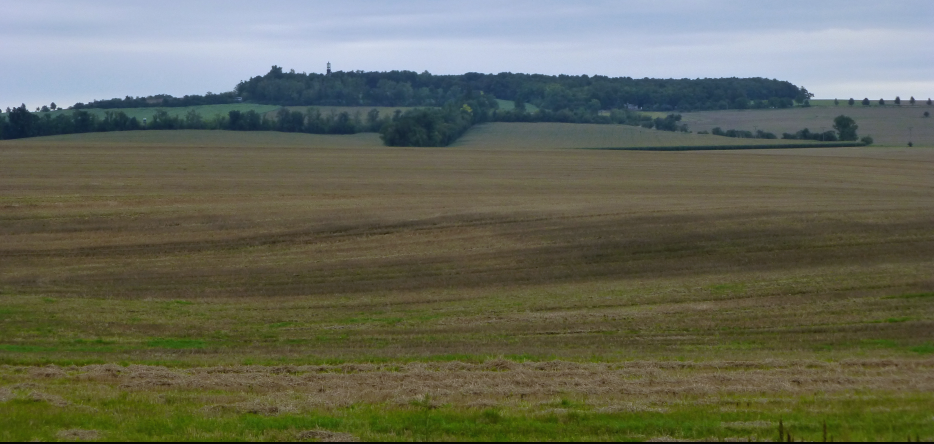
That same day, Napoleon retreated his army and abandoned the Pratzen plateau to the enemy, further convincing his opponents that he was on the verge of retreating and refusing to fight.
A visit from Prince Mikhail Petrovich Dolgoroukov (Михаил Петрович Долгоруков)
Napoleon's troops were concentrated around Brünn, and the Austrian generals, like the Tsar's advisors, were confident that the French, outnumbered as they were, could only consider escaping to Vienna.
They were now convinced of the strength of their position, and decided to fight before the arrival of the second Russian army and the Archduke Charles. As Napoleon wanted, they continued to overextend their left towards Austerlitz and Aujest [Pracký kopec]
On November 30, the Austro-Russians took position on the Pratzen plateau, 324 meters above sea level. Napoleon believed they would come down from there to attack his right, his weakest point. Marshal Jean-de-Dieu Soult would then retake the plateau, cutting the enemy in two. The Emperor recalled Bernadotte's and Davout's troops in anticipation of the battle, which he was now certain was imminent. Davout and his troops travelled one hundred and ten kilometers in forty-eight hours to take part in the battle.
The battlefield
It stretches from the snow-capped Olmutz-Brünn road to the north, to the Vienna-Brünn road to the west, the frozen ponds to the south, and the town of Austerlitz [Slavkov u Brna]
The Austro-Russian position
The Austro-Russian army is organized in seven columns.
The first three form the 30,000-strong left under Fiodor Fiodorovitch Buxhöwden (Фёдор Фёдорович Буксге́вден)
A fourth column, of 17,000 men commanded by Johann Karl von Kollowrath
The fifth column, comprising the cavalry of Prince John of Liechtenstein
The last two columns make up the right-hand side. The sixth, led by Piotr Ivanovich Bagration, will attack Santon
![The Santon hill in Bosenitz The Santon hill in Bosenitz [Tvarožná]](https://media.napoleon-images.us/illustrations/austerlitz-santon-444.png)
Two hundred and seventy-eight cannons supported this position.
This arrangement shows that the Austro-Russians were convinced that the French right wing extended as far as Menitz [Měnín]
As expected, they moved south to surround the French. The northern attacks were just a diversionary tactic. Franz von Weyrother
The French position
On the French side, Soult was positioned on the right, around Puntowitz, with some detachments to the south as far as Sokolnitz
Napoleon's plan was settled, and he held a final meeting with his marshals at 8:30 p.m. on December 1, 1805, to finalize everyone's roles. The Emperor, with his guard and grenadier reserve, would support Bernadotte's attack on Blasowitz [Blažovice]
Napoleon was so confident about his plans that, on the eve of the battle, he issued a proclamation
The Austro-Russians watched these fires and imagined that their opponents, resigned to defeat, were burning down their quarters.
The battle
Napoleon mounted his horse and left his headquarters at four in the morning. He wanted to check that the enemy hadn't made any unexpected movements during the night. Everything confirmed that the enemy continued to push to his left towards Aujest and Telnitz. At the same time, another large contingent of Austro-Russian troops, along with Lichtenstein's cavalry, was marching from the center towards Holubitz [Holubice]
At sunrise
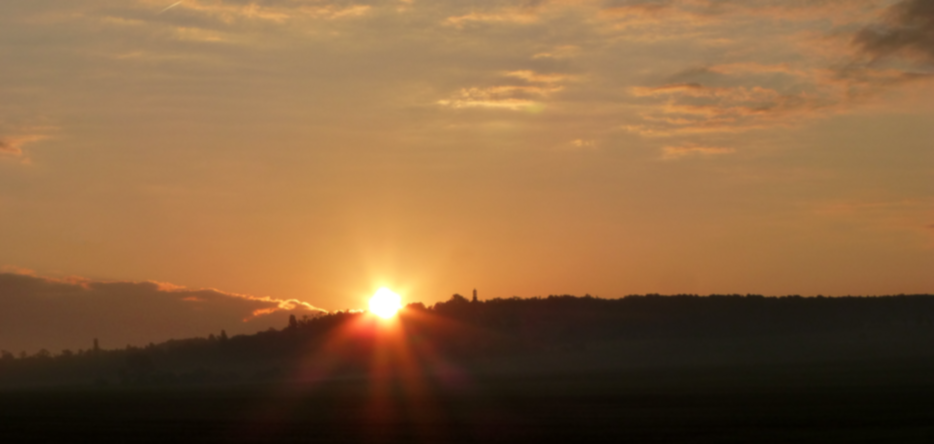
When he was told that the enemy was advancing in force towards Sokolnitz and Telnitz, Napoleon gave the signal for an offensive.
The I, IV and V Corps and the cavalry reserve, commanded by Bernadotte, Soult, Lannes and Murat respectively, set off simultaneously. Bernadotte marched on Blasowitz after crossing Girskowitz, supported on his left by Murat. Lannes moved forward on both sides of the Brünn road, keeping up with the other two marshals. The guard and reserve followed Bernadotte at a distance, keeping a close eye on the center, ready to rush in if the enemy showed any intention of reinforcing there.
Soult, who was commanding the divisions of Louis Charles Vincent Le Blond de Saint-Hilaire
Davout was ordered to leave Raygern [Rajhrad]
When Soult reached the Pratzen plateau, he ran into Kollowrath's fourth Austro-Russian column, which thought itself protected by the third, behind which it was advancing with Emperor Alexander, General Kutuzov and their staffs. A brief but extremely violent battle ensued. The Russian and Austrian battalions were forced in as they formed up for battle. Emperor Alexander had to go to the line to rally his troops, but he had no reserves to restore the situation. The allies were then pushed back to Hostieradek [Hostěrádky-Rešov]
By 9 a.m., the plateau was in Soult's hands, allowing him to set up his artillery at will.
On the far left, Buxhowden only found four battalions in front of him, and was unable to coordinate the attacks of his different columns to take full advantage of his number advantage. He has just emerged from Sokolnitz and Telnitz when Davout arrived from Raygern. The marshal positioned Bourcier's dragoons in front of Telnitz and then took the Friant division with him up the Goldbach stream to Sokolnitz, where the battle was fiercest.
The village was taken and recaptured several times. The melee extended as far as Maxdorf [Dvorska]
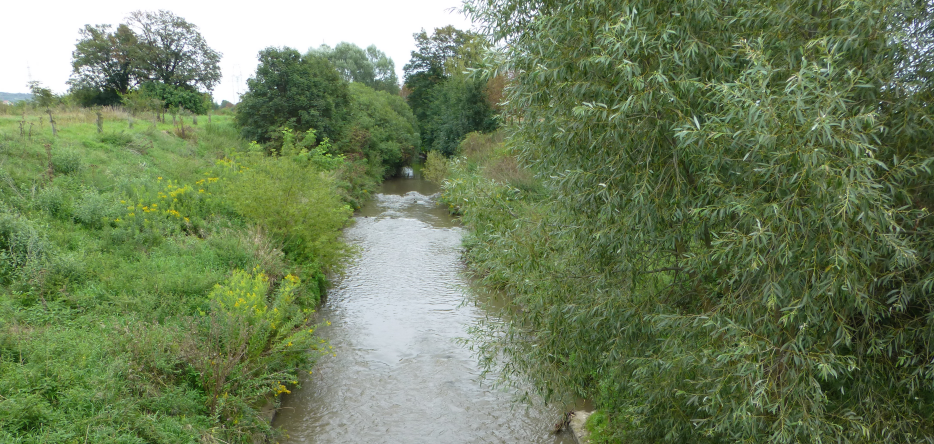
Despite their intensity, these battles were of secondary importance. On the right (north), Bagration marched towards Tvarožná to attack the Santon, a move assisted by Lichtenstein's cavalry and Grand Duke Constantine's reserve. But Lichtenstein, arriving at Kruh
When Lichtenstein arrived, the Russian guard uhlans charged François-Etienne Kellermann's light cavalry. Kellermann fell back between Lannes and Bernadotte. The Russian uhlans, charged by Murat, came under fire from the French infantry, which wiped them out.
The rest of the cavalry was then reclaimed by Kutusov, who tried to reinforce his center and retake the Pratzen plateau from Soult. However, the Prince of Liechtenstein, threatened on all sides and also in demand, sent him only four squadrons, which were only able to witness Kollowrath's defeat.
Thirty other squadrons were placed between Bagration and the Grand Duke. The Grand Duke saw the French marching through Blasowitz and came out to meet them. An intense infantry battle ensued with Jean-Baptiste Drouet d'Erlon's
Meanwhile, to the north of the battlefield, Murat and Lannes gained the upper hand over Bagration, who managed to withdraw in good order. Victory was no longer in doubt and Napoleon moved back to the right, as planned, with some of his guards and Marshal Nicolas-Charles Oudinot's reserve to support Soult and complete the destruction of the enemy left by attacking from the back.
At two o'clock, Sokolnitz was trapped between Soult and Davout, while Aujest was attacked by Vandamme.
At 2 p.m., the French had won the battle.
The Tsar and his staff had realized this an hour early and fled, leaving Kutuzov, the only one who had wanted to avoid the battle, to save what could be saved.
Pribichefski's Russians, surrounded in Sokolnitz, surrendered. Barely half of Langeron's men managed to rally Buxhowden's troops. Buxhowden, after wasting hours in useless skirmishes around Telnitz, decided to retreat towards Aujest, in the hope of getting out of the cul-de-sac he was in.
He set off between two and three o'clock, walking between lakes and high ground. Vandamme's attack on Aujest surprised him as the head of the Russian column exited the village. The two leading battalions, with Buxhowden himself, continued on, but the remaining 28 battalions got stuck between the lakes and the French-held heights. The head of the column, with its artillery and escorting troops, tried to escape across the frozen lake. The ice broke under the weight of the French cannonballs, swallowing up men and guns [1].
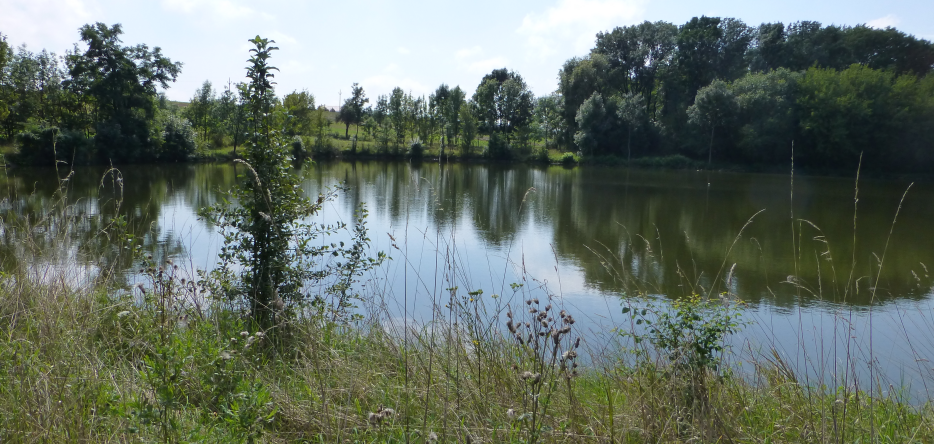
The rest of the fugitives resigned to following the lake shore under enemy fire to a dike separating the Telnitz and Melnitz [Měnín] lakes
The Austro-Russians were defeated on all sides, forced back onto the Waschan road
They were still under the double threat of Davout - whose division was about to arrive at Nicolsbourg [Mikulov]
Conclusion
The battle lasted less than nine hours and cost the Austro-Russians 27,000 men (16,000 dead and wounded, 11,000 prisoners), 185 cannons (which provided the raw material for the Vendôme column
Meanwhile, the French suffered 1,500 dead, almost 7,000 wounded, several hundred prisoners and the loss of an eagle belonging to the 4th regiment of the line, which Napoleon found particularly distressing.
The Austrian emperor's army was in a state of disarray, and he had no choice but to ask the victor for his terms. In the early hours of December 3, Prince John of Liechtenstein was received by Napoleon, along with Marshals Murat and Lannes, at the Stará Posta bivouac
The following day, the Emperors of France and Austria met at the Burnt Mill [Spaleny Mlyn] in Januv Dvur
Consequences
The Austrian emperor might have been afraid of losing everything by continuing to fight, but Napoleon had a strong interest in putting an end to the conflict, since powerful Austrian reinforcements were approaching from the four corners of the empire, and Prussia was on the verge of joining the coalition.
Under these conditions, the two parties came to an agreement without much difficulty, and on December 26, Austria signed the Treaty of Presburg [de nos jours Bratislava]
The treaty marked the end of the Holy Roman Empire and the acceptance of French hegemony in Italy. Austria had to pay heavy compensation, lose important territories and four million inhabitants, giving France free reign over what was to become the Confederation of the Rhine.
The Third Coalition came to an end; England, which was absent from this battle, was the only one left to face France.
Map of the battle of Austerlitz - Situation on December 1, 1805 at 6 p.m.
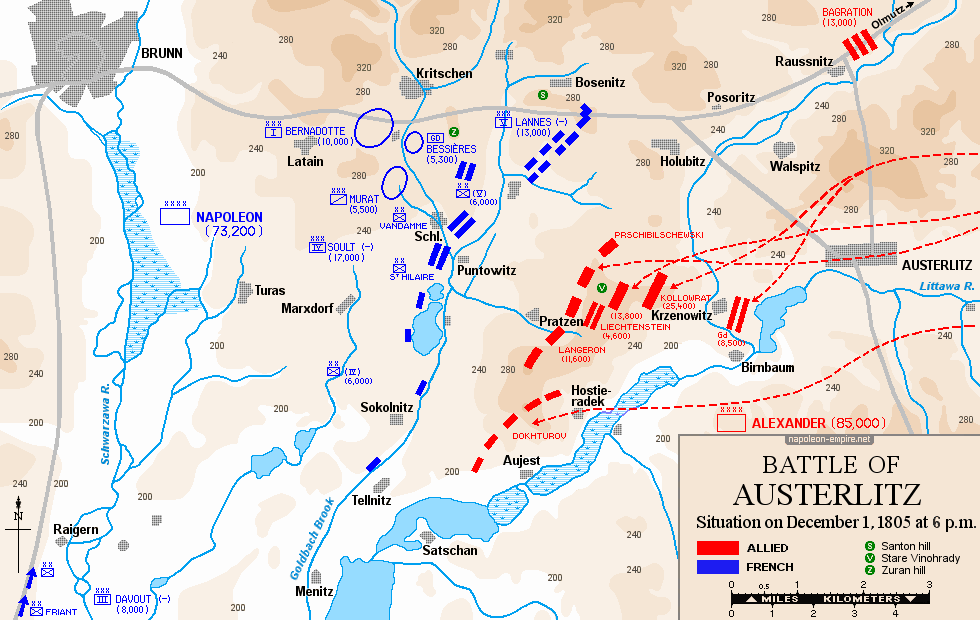
Map of the battle of Austerlitz - Situation on December 2, 1805 at 9 a.m.
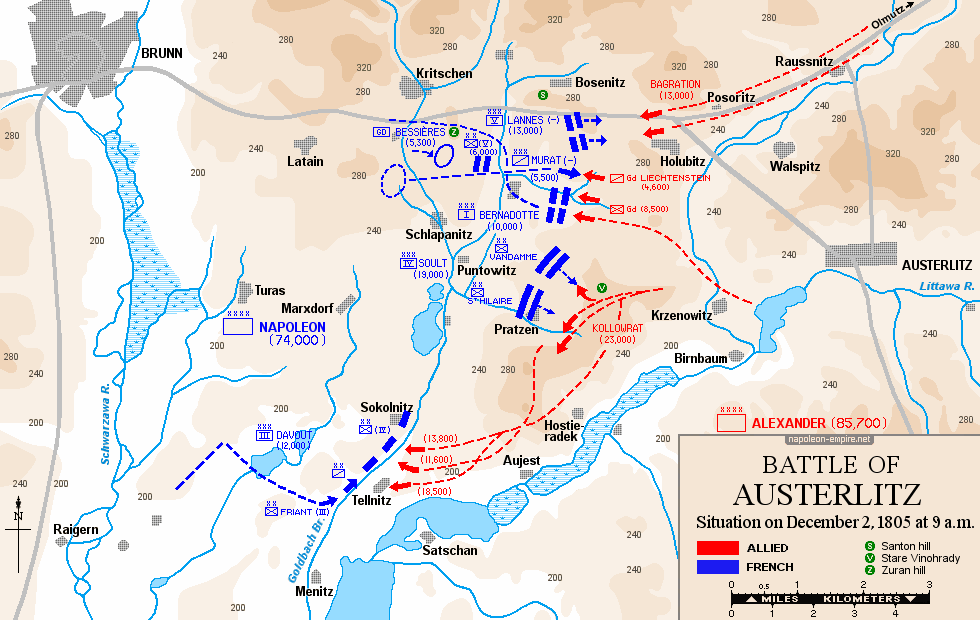
Map of the battle of Austerlitz - Situation on December 2, 1805 at 2 p.m.
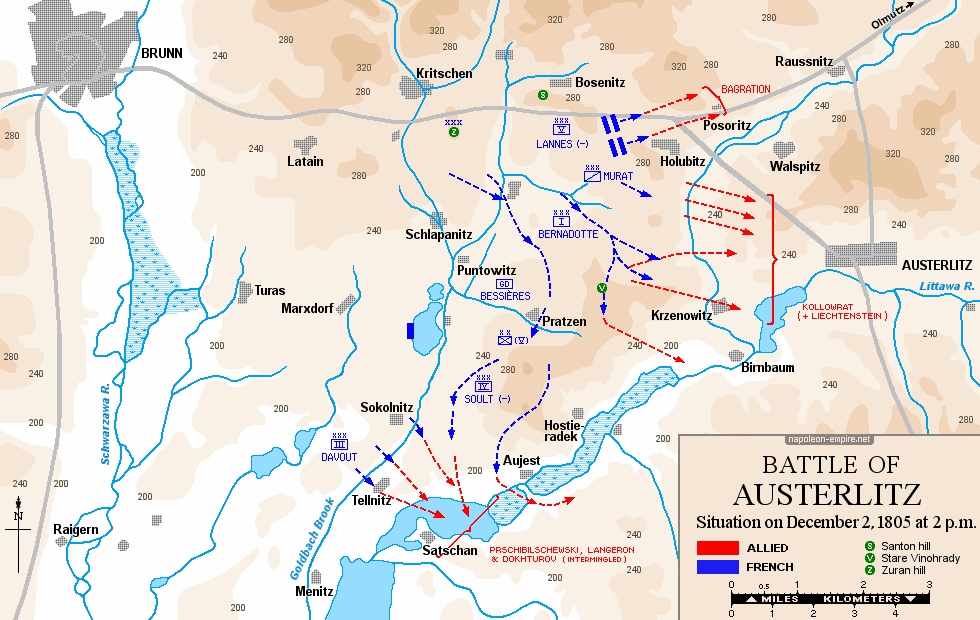
Picture - "The Battle of Austerlitz". Painted 1810 by baron François Pascal Simon Gerard.

The battle of Austerlitz is considered Napoleon's tactical masterpiece, and is still studied in military schools. The Emperor achieved the unique feat of choosing the terrain, bringing the enemy to it and imposing his plan.
A map table
[1] The number of soldiers lost in the frozen ponds seems to have been greatly overestimated. The French only found a few bodies a few days later when searching for cannons. It's possible that some of the drowned soldiers were recovered beforehand, but the true number of victims is certainly far from the figures that are sometimes quoted, which can reach several thousand men. ↑